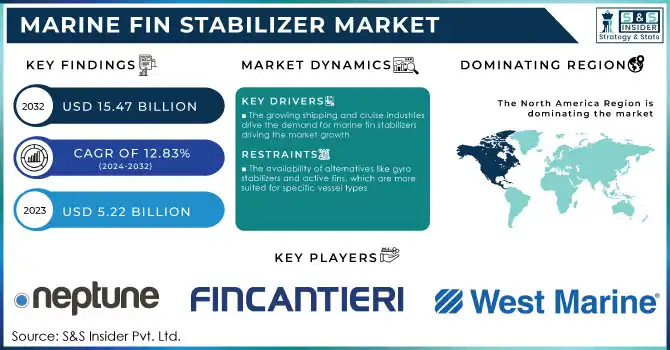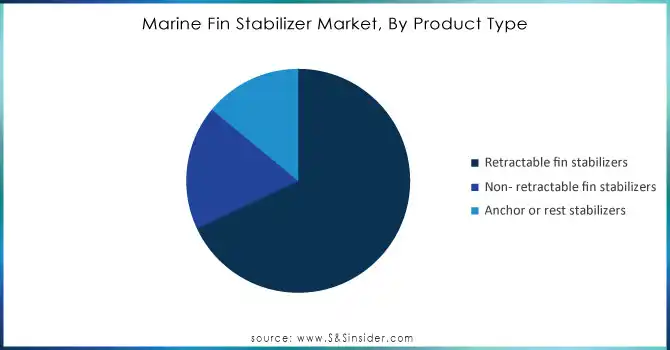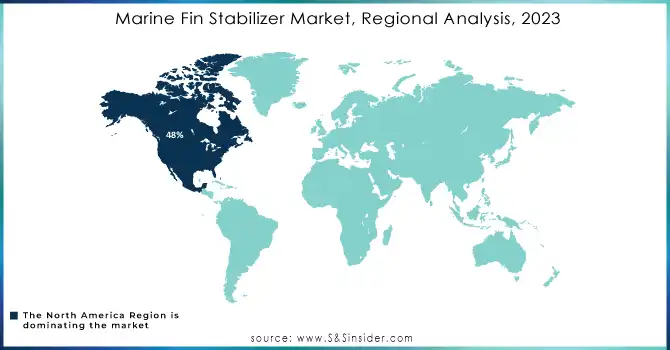Marine Fin Stabilizer Market Key Insights:

Get More Information on Marine Fin Stabilizer Market - Request Sample Report
The Marine Fin Stabilizer Market size was valued at USD 5.22 Billion in 2023 and will reach USD 15.47 Billion by 2032 with a growing CAGR of 12.83% over the forecast period of 2024-2032.
The marine fin stabilizer market driven by increasing demand for enhanced passenger comfort and safety in the maritime industry. As vessels become more sophisticated and travel longer distances, the need to reduce roll motion and ensure stability on turbulent waters has propelled the adoption of advanced stabilization systems. These systems use a set of fin stabilizers that adjust dynamically to the motion of the ship, effectively minimizing the effects of waves and providing a smoother ride. The technology's evolution has led to systems that are not only more efficient but also energy-saving, contributing to the growing focus on sustainability within the industry. The rise in global maritime tourism, particularly cruise lines, has fueled the demand for marine stabilizers. As passengers expect a more comfortable experience, cruise operators are increasingly investing in advanced stabilization systems. The commercial shipping sector, too, benefits from these systems, as they help reduce cargo loss and damage by maintaining a steady course during rough seas.
The development of active fin stabilizers that respond to changing conditions in real-time, as well as the integration of smart sensors and automated control systems, has enhanced the effectiveness and ease of use of these stabilizers. Furthermore, there is a noticeable trend toward retrofitting older vessels with newer stabilization technology to improve operational efficiency and reduce maintenance costs. Another trend in the market is the rising preference for hybrid systems that combine fin stabilizers with other forms of stabilization, such as gyroscopic stabilizers or active trim systems, to optimize performance across various types of vessels. With the growing emphasis on passenger comfort, safety, and operational efficiency, the marine fin stabilizer market is set to continue its upward trajectory. The global push for greener and more energy-efficient solutions is likely to further accelerate adoption, particularly as ship operators seek to meet stricter environmental regulations.
Marine Fin Stabilizer Market Dynamics
DRIVERS
-
The growing shipping and cruise industries drive the demand for marine fin stabilizers driving the market growth
The growth of the marine fin stabilizer market is largely driven by the increasing demand for comfort and safety within the shipping and cruise industries. As global maritime activities expand, especially in the cruise sector, passengers expect smoother and more enjoyable travel experiences. Marine fin stabilizers play a critical role in achieving this by minimizing the roll of ships, ensuring a stable and comfortable journey even in rough waters. This is particularly important for cruise ships, where passenger comfort is a top priority, as well as for commercial vessels that transport goods over long distances. As a result, marine fin stabilizers have become essential in both recreational and commercial maritime operations, leading to a significant rise in their adoption.
The demand for these stabilizers is also fueled by the growing number of tourists opting for cruises and the expansion of global trade, which involves larger, more sophisticated vessels. These ships need advanced stabilizing technologies to maintain stability and prevent discomfort or potential damage during transit. The enhanced safety offered by stabilizers also reduces the risk of accidents or incidents caused by vessel instability, further driving their importance in the maritime industry. As such, marine fin stabilizers have become indispensable in ensuring smooth, safe voyages, prompting a steady market growth fueled by the increasing demand for comfort, safety, and operational efficiency across maritime sectors.
RESTRAIN
-
The availability of alternatives like gyro stabilizers and active fins, which are more suited for specific vessel types
The availability of alternative stabilizing systems, such as gyro stabilizers and active fins, presents a challenge to the growth of the marine fin stabilizer market. These alternatives are designed to achieve similar stability outcomes, but they may be more suitable for specific vessel types or operational needs, thus limiting the overall market share for traditional fin stabilizers. Gyro stabilizers, for instance, are particularly effective in reducing roll on smaller or luxury vessels, offering advantages such as compactness and the ability to operate without external moving parts. Similarly, active fins, which adjust automatically in response to wave conditions, are often more versatile and efficient in stabilizing vessels under varying sea conditions.
As a result, ship owners and operators may opt for these alternatives based on factors such as vessel size, usage, or cost-effectiveness, which could slow down the widespread adoption of fin stabilizers in certain sectors. For instance, while fin stabilizers are ideal for larger ships or commercial vessels, smaller cruise ships, yachts, or military vessels may find gyro or active fins to be better suited for their operational requirements, leading to market fragmentation. The cost considerations associated with installing and maintaining marine fin stabilizers also add to this challenge, as these alternatives often come with lower upfront costs or simpler maintenance needs. While the marine fin stabilizer market is growing, these competing technologies could limit its growth potential in certain segments of the maritime industry.
Marine Fin Stabilizer Market Segmentation Analysis
By Product Type
Retractable fin stabilizers segment dominated with the market share over 68% in 2023, due to their advanced technology and superior performance in providing stability across various sea conditions. These stabilizers are designed to retract when not in use, which reduces drag, thus improving fuel efficiency and overall vessel performance. Their ability to be deployed or retracted as needed offers greater flexibility, making them ideal for vessels that require high-performance stabilization in turbulent waters. Additionally, retractable fin stabilizers are highly effective in reducing the roll of the ship, enhancing passenger comfort and safety, particularly on large cruise ships and luxury yachts. The combination of their performance benefits, reduced fuel consumption, and operational flexibility has led to their widespread adoption in the marine industry, making them the preferred choice for vessels operating in diverse and challenging maritime environments.

Need Any Customization Research On Marine Fin Stabilizer Market - Inquiry Now
By Fit Type
The Retro Fit segment dominated with the market share over 58% in 2023. This growth is driven by the need for cost-effective upgrades to existing vessels. Retrofitting allows shipowners to enhance stability without the expense of building new vessels or opting for an entirely new stabilization system. As technological advancements have made retro fit solutions more efficient and adaptable, it has become a popular choice for upgrading older ships with the latest stabilization technologies. Additionally, stricter regulations on ship performance and safety are encouraging vessel operators to retrofit their fleets to comply with new standards.
Marine Fin Stabilizer Market Regional Overview
North America region dominated with the market share over 48% in 2023, due to its well-established marine industry, which includes a robust commercial shipping sector and a thriving recreational boating market. The demand for advanced stabilization systems is high, as these technologies enhance vessel performance, comfort, and safety. Additionally, North America benefits from continuous technological advancements and strong investments in marine innovations, which further bolster its dominance in the market.
The Asia-Pacific region is experiencing the fastest growth in the Marine Fin Stabilizer Market. Countries like China, Japan, and South Korea are rapidly expanding their maritime industries, with increasing shipbuilding activities and improvements in port infrastructure. The demand for superior vessel stability systems is driven by the need for enhanced performance in both commercial shipping and luxury yachts. As the region's shipping industry continues to grow, coupled with rising investments in marine technology, the market for stabilizers in Asia-Pacific is seeing significant expansion.

Some of the major key players of Marine Fin Stabilizer Market
-
Neptune (Marine stabilizer systems)
-
Groupe Foure Lagadec (Hydraulic fin stabilizers, anti-roll systems)
-
Fincantieri S.p.A (Marine stabilization systems)
-
SKF Group (Marine bearings, stabilization solutions)
-
Western Marine Electronics Inc. (Marine stabilizer control systems)
-
Imtra Corp (Marine stabilizer solutions, hydraulic systems)
-
Kongsberg Maritime (RRCM) (Marine stabilizers, dynamic positioning systems)
-
The NAIAD Dynamics US Inc (Hydraulic stabilizers, roll damping systems)
-
Mitsubishi Heavy Industries (Marine stabilization systems, ship stabilization technology)
-
Quantum Marine Stabilizers (Active fin stabilizers, gyroscopic stabilizers)
-
Matn’s Stabilizers (Custom-built stabilizer systems for yachts and vessels)
-
CMC Marine Srl (Stabilization systems, gyro stabilization)
-
ABT TRAC (Fin stabilizers, active fins, gyrostabilizers)
-
Rotorswing Marine United Kingdom (Marine stabilizer systems, rotorswing technology)
-
WTSV Technologies (Stabilizer control systems, automation solutions)
-
Rolls-Royce (Fin stabilizers, ship dynamics management)
-
Seakeeper (Gyroscopic stabilizers, active stabilization systems)
-
Veem Propellers (Veem Stabilizers, hydraulic stabilization)
-
Veth Propulsion (Veth Stabilizers, active fins)
-
Damen Shipyards Group (Marine stabilizer technology, stabilization and roll control systems)
Suppliers for advanced stabilizer systems and propulsion technologies of Marine Fin Stabilizer Market
-
Rolls-Royce Marine
-
Nybø Marine
-
Veem Limited
-
Active Stabilization Systems (ASS)
-
Baiyun Marine
-
Marine Technologies
-
Side-Power (Sleipner Motor)
-
STEELAGE STABILIZER
-
Hug Engineering
-
Fincantieri
RECENT DEVELOPMENTS
-
In January 2024: Rolls-Royce introduced its WaveInterceptor 4000QS fin stabilizer system for superyachts, offering superior roll reduction, quieter performance, and lower energy use. Designed for yachts between 40 and 60 meters, it enhances stability in rough seas through advanced algorithms and hydrodynamic design, improving comfort and safety.
-
In September 2024: CMC Marine announced a partnership with Dometic to integrate its stabilizer technology with the Optimus steering system, enhancing comfort, maneuverability, and safety at sea. The collaboration combines CMC's fin stabilization systems with Dometic's steering expertise for improved vessel performance.
| Report Attributes | Details |
|---|---|
| Market Size in 2023 | USD 5.22 billion |
| Market Size by 2032 | USD 15.47 billion |
| CAGR | CAGR of 12.83% From 2024 to 2032 |
| Base Year | 2023 |
| Forecast Period | 2024-2032 |
| Historical Data | 2020-2022 |
| Report Scope & Coverage | Market Size, Segments Analysis, Competitive Landscape, Regional Analysis, DROC & SWOT Analysis, Forecast Outlook |
| Key Segments | • By Product Type (Retractable fin stabilizers, non-retractable fin stabilizers, Anchor or rest stabilizers) • By Vessel Type (Passenger Vessels (Passenger & Vehicle Ferries, Cruise Ships, Yachts & Superyachts), Naval and Coast Guard Vessels, Fishing Vessels, Merchant Vessels) • By Fit Type (First Fit, Retro Fit) |
| Regional Analysis/Coverage | North America (US, Canada, Mexico), Europe (Eastern Europe [Poland, Romania, Hungary, Turkey, Rest of Eastern Europe] Western Europe [Germany, France, UK, Italy, Spain, Netherlands, Switzerland, Austria, Rest of Western Europe]), Asia Pacific (China, India, Japan, South Korea, Vietnam, Singapore, Australia, Rest of Asia Pacific), Middle East & Africa (Middle East [UAE, Egypt, Saudi Arabia, Qatar, Rest of Middle East], Africa [Nigeria, South Africa, Rest of Africa], Latin America (Brazil, Argentina, Colombia, Rest of Latin America) |
| Company Profiles | Neptune, Groupe Foure Lagadec, Fincantieri S.p.A, SKF Group, Western Marine Electronics Inc., Imtra Corp, Kongsberg Maritime, The NAIAD Dynamics US Inc, Mitsubishi Heavy Industries, Quantum Marine Stabilizers, Matn’s Stabilizers, CMC Marine Srl, ABT TRAC, Rotorswing Marine United Kingdom, WTSV Technologies, Rolls-Royce, Seakeeper, Veem Propellers, Veth Propulsion, Damen Shipyards Group. |
| Key Drivers | • The growing shipping and cruise industries drive the demand for marine fin stabilizers, as they enhance passenger comfort and safety by reducing ship roll, ensuring smoother voyages. |
| Restraints | • The availability of alternatives like gyro stabilizers and active fins, which are more suited for specific vessel types, may restrict the market growth of marine fin stabilizers. |

